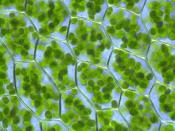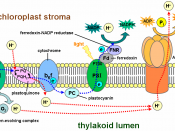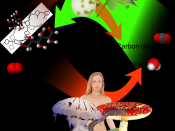Introduction: Photosynthesis is the process by which green plants use the light energy to convert carbon dioxide and water into simple sugar called glucose, which provides a basic energy source for the plant. Photosynthesis occurs in leaves that contain specialized cell structures called chloroplasts. Chloroplasts contain molecules of a green pigment called chlorophyll, consisting largely of carbon and hydrogen. It gives green color and absorbs the necessary light for photosynthesis. Chloroplasts are found in palisade cells, they have a large surface area, which means there is more change of light hitting a chloroplast. Light is a very important factor when it comes to the process of photosynthesis, without light the reaction cannot be carried out and no glucose can be made. Light intensity is one of the factors that affect the rate of photosynthesis and that is what our experiment is based on:
Aim: In this experiment we shall investigate how the rate of photosynthesis (measured by the increased volume of oxygen) is affected by changes of light intensity in water plants.
Hypothesis: I predict that as the intensity of light increases, so will the rate of photosynthesis. Furthermore, I hypothesise that if the light intensity increases, the rate of photosynthesis will increase at a proportional rate.
Variables:
Constant VariedMeasured
ShootLight intensityRate of photosynthesis
Number of lightsDistance between light and pondweedNumber of Bubbles
Water ------
Time between each result recording ------
Materials:
- Beaker almost full of water
- Pondweed
- 60 watt Lamp
- Ruler
- Stopwatch
- Short-stemmed Funnel
- Test Tube
-paper clip
-pure CO2
Method:
1. First clip that end of the pondweed that was not cut.
2. Then place a short-stemmed funnel over some pondweed in a beaker of water. Add pure CO2 to the beaker of water.
3. Fill a test tube with water...



Light saturation point
The decrease is caused by the light saturation point.. though I am not very clear of what it means..
0 out of 0 people found this comment useful.